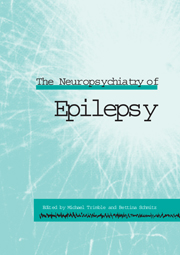Book contents
- Frontmatter
- Contents
- List of contributors
- Part I Background
- Part II Clinical aspects
- Part III Cognitive aspects
- Part IV Nonepileptic attacks
- Part V Treatment complications
- Part VI Treatment
- 20 On the use of psychotropic drugs in patients with seizure disorder
- 21 The role of psychotherapy in the treatment of epilepsies
- 22 Choosing measures to assess quality of life (QOL) in epilepsy
- Index
20 - On the use of psychotropic drugs in patients with seizure disorder
Published online by Cambridge University Press: 05 October 2010
- Frontmatter
- Contents
- List of contributors
- Part I Background
- Part II Clinical aspects
- Part III Cognitive aspects
- Part IV Nonepileptic attacks
- Part V Treatment complications
- Part VI Treatment
- 20 On the use of psychotropic drugs in patients with seizure disorder
- 21 The role of psychotherapy in the treatment of epilepsies
- 22 Choosing measures to assess quality of life (QOL) in epilepsy
- Index
Summary
Introduction
It is now accepted that many patients with epilepsy have psychiatric problems. Recent epidemiological evidence from selected clinics suggests that over 50% of patients may have a recognizable psychiatric disorder (Krishnamoorthy and Trimble, unpublished data). It is also known that many patients with epilepsy receive psychotropic drugs, sometimes, but not always, on account of their psychiatric symptoms. Thus, it has to be acknowledged that there is an overlap between anticonvulsant drugs and psychotropic agents, such that many of the former are known to have mood-regulating properties, while a number of the latter (for example, benzodiazepines) have anticonvulsant properties.
A classification of psychotropic drugs currently in use is given in Table 20.1.
The main part of this text relates to the prescription of antidepressant and antipsychotic drugs in patients with epilepsy, and then a brief comment will be made about some of the other agents.
Antidepressant drugs seizures and epilepsy
Ever since the introduction of tricyclic drugs into clinical practice, seizures have been recognized as a side effect. This has been reviewed on several occasions (Trimble, 1980, 1987).
The position has changed in the last few years because of the introduction of a number of new antidepressant drugs, and following a brief review of the older literature, these will be discussed.
- Type
- Chapter
- Information
- The Neuropsychiatry of Epilepsy , pp. 299 - 312Publisher: Cambridge University PressPrint publication year: 2002
- 1
- Cited by



